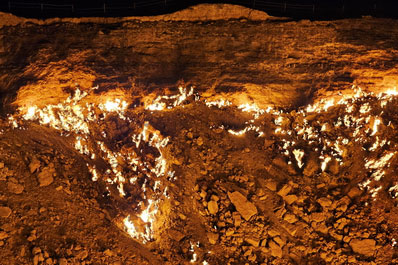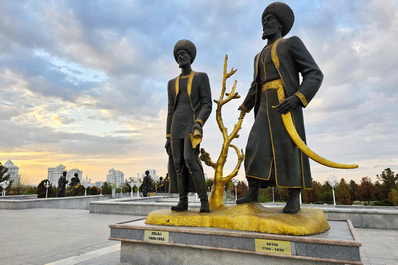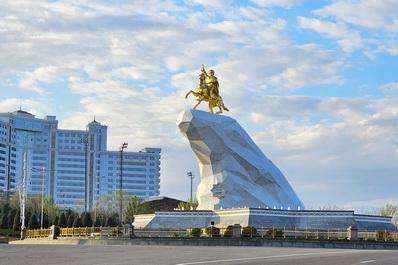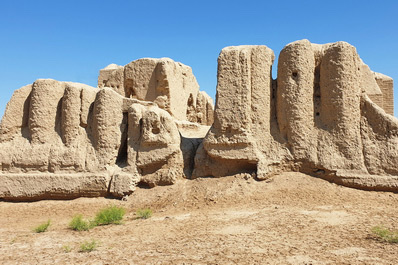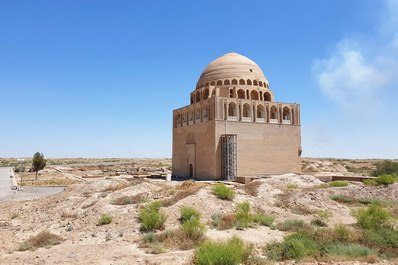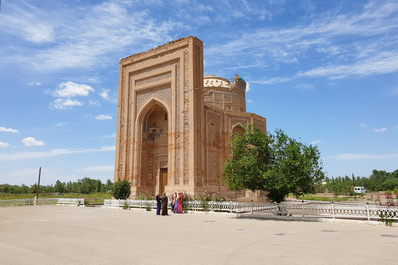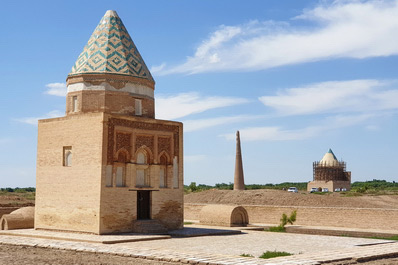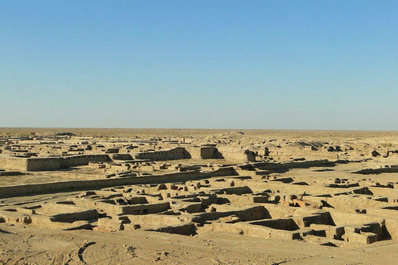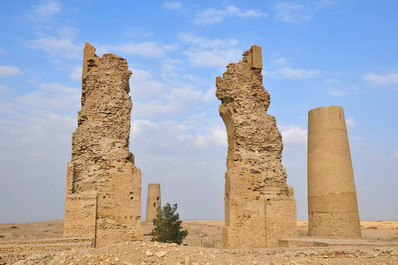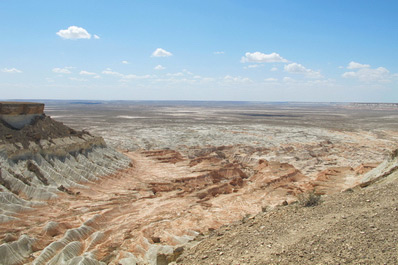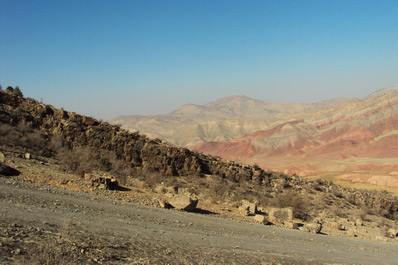Turkmenistan Attractions
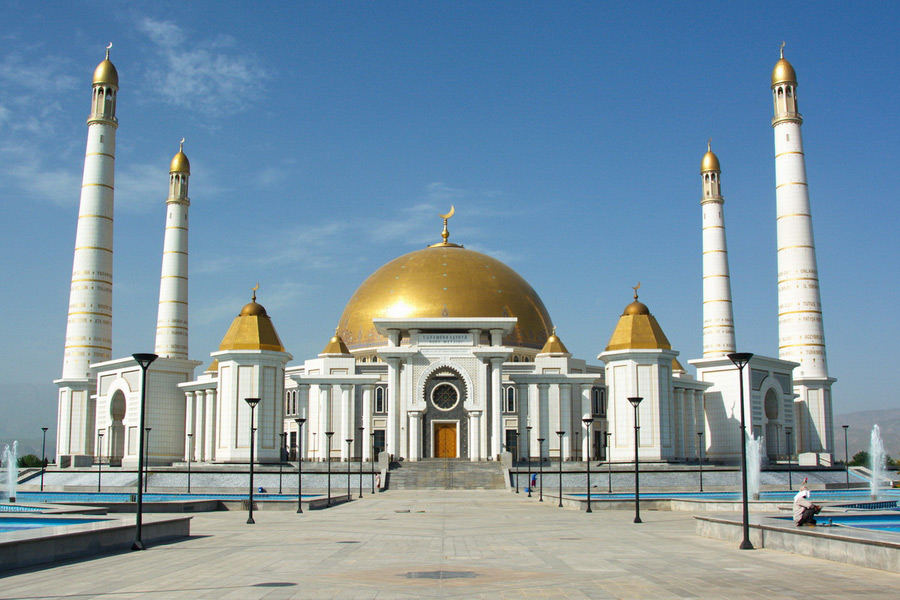
Attractions of Turkmenistan are unique monuments in one of the world's most mysterious countries. Turkmenistan attractions include ancient cities with centuries-old mausoleums and fortresses, modern cities with monumental white marble architecture, and stunning natural spots in remote corners of the country.
In this article, we've gathered the most interesting and impressive attractions of Turkmenistan, perfect for including in a tour of the most desolate land in Central Asia.
Darvaza Gas Crater
Darvaza is the top attraction for travelers visiting Turkmenistan. Located in the heart of the Karakum Desert, 200 km from the nearest major city, this large crater has a diameter of 70 meters, with flames that have been burning at the bottom for over 50 years. Flames burst out of hundreds of crevices, sometimes reaching heights of up to 2 meters. During the day, the crater seems ordinary, but after sunset, it creates a mystical atmosphere, earning it the name "Door to Hell" or “Gates of Hell”. It's a must-visit spot because no one knows when the natural gas reserves will deplete, and the flames will extinguish.
Ashgabat
The capital of Turkmenistan is the most modern, vibrant, and impressive city in the country. In recent decades, numerous monumental structures have been built here, and new buildings are clad in white marble, earning the city a spot in the Guinness Book of Records. In Ashgabat, be sure to visit Independence Park, the Monument of Neutrality, Ertugrul Gazi Mosque, and the State Museum of Turkmenistan. Nearby, tourists often explore the massive Turkmenbashi Ruhy Mosque and the ancient ruins of Old Nisa. Don't miss an evening stroll through the city when thousands of lights illuminate, giving it a Las Vegas-like glow.
Merv
Merv is one of the oldest cities in Central Asia, with a history spanning over 2700 years. It has fallen into decline and been revived multiple times. Today, Merv comprises several settlements from different eras. The youngest buildings date back to the 15th century, while the oldest structures are barely distinguishable clay mounds. Merv is located 30 kilometers east of the modern city of Mary, from where day tours depart. During the tour, you can explore the ruins of the Kyz-Kala and Erk-Kala fortresses and visit the mosques of Yusuf Hamadani and the impressive Sultan Sanjar mausoleum.
Kunya Urgench
This ancient city now lies in ruins in the northern part of the country near the Uzbekistan border. Kunya Urgench is often visited during short tours from Nukus and Khiva in Uzbekistan. The city is home to the Kutlug-Timur minaret, which stands over 60 meters high, making it the tallest structure of the Middle Ages in Central Asia. Kunya Urgench also features several mausoleums with unique architecture, distinct from other regional monuments. Since the monuments are spread out, some parts of the tour can be done by car, while other parts require walking. A tour of Kunya Urgench typically takes at least half a day.
Explore these remarkable Turkmenistan attractions, known for the rich history and breathtaking beauty.
Other Historical Attractions of Turkmenistan
Beyond Merv, Kunya Urgench, and Old Nisa, Turkmenistan boasts numerous archaeological sites scattered across its vast desert terrain. These sites will captivate even the most passionate history enthusiasts. Some can be included in an extensive Turkmenistan trip, while others are so remote that visiting them feels like a true expedition.
Gonur-depe: An ancient settlement over 4,000 years old, located 70 km north of Mary in the eastern Karakum Desert.
Dehistan: An ancient settlement that dates back 2,300 years, situated in the southwestern part of Turkmenistan, 320 km from Ashgabat.
Yekedeshik: A cave city believed to be built around the 1st century BC, located 200 km south of Mary.
Serakhs: An ancient settlement over 4,000 years old, with only the Yarty-Gumbez Mausoleum from the 11th century remaining, located 130 km southwest of Mary.
Natural Attractions of Turkmenistan
Besides cultural and historical monuments and the Darvaza Crater, Turkmenistan also has some breathtaking natural attractions. Despite 75% of the country being covered by monotonous desert, there's always room for vivid and unforgettable experiences.
Yangi-Kala Canyon: A stunning spot with brightly colored rocks and colossal cliffs, located 170 km east of Turkmenbashi.
Dinosaur Plateau: A giant slab 200 meters long, marked with hundreds of footprints from ancient Jurassic lizards, situated 100 km from Magdanly.
Kov-Ata Underground Lake: Located in Baharden Cave, this lake is known for its healing properties and is 90 km from Ashgabat.
Turkmenistan offers many more fascinating historical and natural sights that will intrigue travelers. Even the mentioned monuments and locations will give you a magnificent image of the country, making it feel less mysterious. Create your list of desired Turkmenistan attractions, and we'll organize an unforgettable trip for you. Or choose one of our tours, which include the most popular attractions of Turkmenistan.


